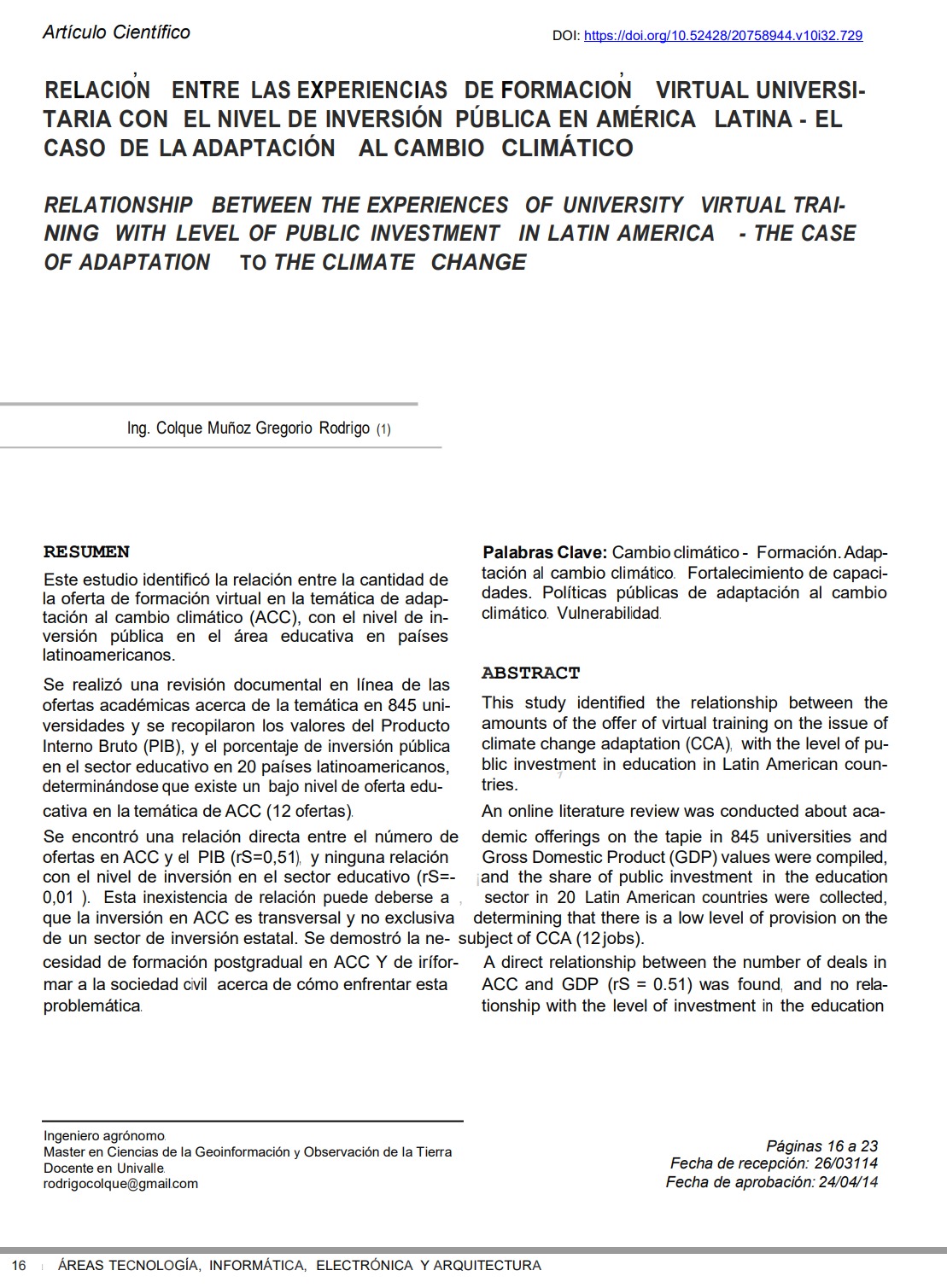Relationship between the Experiences of University Virtual Training with Level of Public Investment in Latin America - The Case of Adaptation to the Climate Change
DOI:
https://doi.org/10.52428/20758944.v10i32.729Keywords:
Climate Change Training, Adapting to climate change, Capacity building, Public policies far adaptation to climate change, VulnerabilityAbstract
This study identified the relationship between the amounts of the offer of virtual training on the issue of climate change adaptation (CCA), with the level of public investment in education in Latin American countries. An online literature review was conducted about academic offerings on the tapie in 845 universities and Gross Domestic Product (GDP) values were compiled, and the share of public investment in the education sector in 20 Latin American countries were collected, determining that there is a low level of provision on the subject of CCA (12 jobs). A direct relationship between the number of deals in ACC and GDP (rs = 0.51) was found, and no relationship with the level of investment in the education sector (rs = 0.01) was found. This lack of relationship may be due to investment in CCA is transverse and not exclusive to a sector of state investment. The need far CCA postgraduate training and inform civil society about how to deal with this problem was demonstrated.
Downloads
References
(1) López, E. El proceso de formación de las competencias creativas. Una necesidad para hacer más eficiente el aprendizaje de los estudiantes universitarios. Universidad de Pinar del Río. 2001 . http://www.rieoei.org/deloslectores/1593Lopez.pdf (25 abril 2013).
(2) Tedesco, J. C. La educación y los nuevos desafíos de la formación del ciudadano. Nueva Sociedad. 1996. http://www.nuso.org/revista.php?n=146 (13 junio2013).
(3) Margalef, L. y Álvarez, J. La formación del profesorado universitario para la innovación en el marco de la integración del Espacio Europeo de Educación Superior. 2005. http://www.revistaeducacion.mec.es/re337/re337 _04.pdf (13 abril 2013)
(4) Facundo, A.H. La educación superior a distancia/virtual en Colombia. En: Digital Observatory for higher education in Latin America and the Carib bean. 2003. www.iesalc.unesco.org.ve (30 abril 2013).
(5) Henao, O. La enseñanza virtual en la Educación Superior.2002. http://www.pucmm.edu.do/rsta/academico/te/documents/ed/eves.pdf (20 septiembre 2013).
(6) Cano, O. Antecedentes internacionales y nacionales de las TIC a nivel superior: Su trayectoria en Panamá.2012.http://revista.inie.ucr.ac.cr/uploads/tx_magazine/antecedentes•internacionales•nacionales•tic•nivel•superior•trayectoria•panama•cano_01.pdf (27 septiembre 2013).
(7) IPCC. Summary for Policymakers. In: Climate Change 2013: The Physical Science Basis. Contribution of Working Group I to the Fifth Assessment Report of the lntergovernmental Panel on Climate Change [Stocker, T.F., D. Qin, G.•K. Plattner, M. Tignor, S. K. Allen, J. Boschung, A. Nauels, Y. Xia, V. Bex and P.M. Midgley (eds.)].Cambridge University Press, Cam• bridge, United Kingdom and New York, 2013.
(8) PNUD. América Latina y el Caribe: Una superpotencia de Biodiversidad. Un documento de política. 2010. http://www.undp.org.ar/docs/lnformes_y_Documentos/informehabitat/Policy_Brief_S PA.pdf (5 Octubre 2013).
(9) Sandía, B., Montilva, J. y Barrios, J. Cómo evaluar cursos en línea. Educere. 2005. http://www.scielo.org.ve/scielo.php?pid=S131649102005000400013&script=sci_arttext (20 abril 2013).
(1 O) Martinez, R. et al. El coeficiente de correlación de los rangos de Spearman caracterización. Revhabanciencméd. 2009. <http://scielo.sld.cu/scielo.php?script=sci_arttext&pid= S1729519X2009000200017&1ng=es&nrm=iSO>. ISSN1729 519X (20 septiembre 2013).
(11) IPCC. Cambio Climático. Informe de Síntesis. Informe del Grupo lntergubernamental de Experto sobre Cambio Climático. 2007. http://www.ipcc.ch/pdf/assessmentreport/ar4/syr/ar4_syr_sp.pdf (1 O abril 2013).
(12) Stern, R. La economía del Cambio Climático. 2007. http://www.pesic.org/Archivos%20de%20Descarga/Otros%20doc%20de%201nteres/lnforme%20STERN.pdf (20 abril 2013)
(13) Gutierrez, L. et al. El cambio climático y su impacto económico. 2008. http://www.peccuv.mx/descargas/pdf/reportes_investigacion/Cap%C3%ADtu lo%205%202%20El%20Cambio%20Clim%C3%A1 tico%20y%20su%201mpacto%2Oen%201a%20Econom%C3%ADa.pdf (30 noviembre 2013).
(14) Ríos, C. y Herrero, V. La producción científica la tinoamericana y la ciencia mundial. Una revisión bibliográfica (1989 2003). 2005. http://eprints.rclis.org/9071 /1 /la_produccion_cientifica_latinoamerica_y _la_ciencia.pdf (3 noviembre 2013).
(15) COSUDE. Sistematización del Programa de Reducción del Riesgo de Desastres, Fase 11. Experiencias ejecutadas en alianzas institucionales. PRRD. La Paz: COSUDE, 201 O.
(16) Foro en Ciencia, Tecnología e Innovación para el Desarrollo Sostenible, Co • Convenorsrecomendations and summaries. Climate changes and other environ mental changes. 2012. http ://www. icsu. o rg/rio20/sci ence•and•tech nologyfo ru m/prog ramme/fo ru m%20recom mend atio n s/cl imate•change•and•other•environmental•changes (1 Ooctubre 2013).

Downloads
Published
How to Cite
Issue
Section
License
Copyright (c) 2014 Colque Muñoz Gregorio Rodrigo

This work is licensed under a Creative Commons Attribution 4.0 International License.
Authors who publish with this journal agree to the following terms:
- Authors retain copyright and grant the journal right of first publication with the work simultaneously licensed under a Creative Commons Attribution License 4.0 that allows others to share the work with an acknowledgement of the work's authorship and initial publication in this journal.
- Authors are able to enter into separate, additional contractual arrangements for the non-exclusive distribution of the journal's published version of the work (e.g., post it to an institutional repository or publish it in a book), with an acknowledgement of its initial publication in this journal.
- Authors are permitted and encouraged to post their work online (e.g., in institutional repositories or on their website) prior to and during the submission process, as it can lead to productive exchanges, as well as earlier and greater citation of published work.














